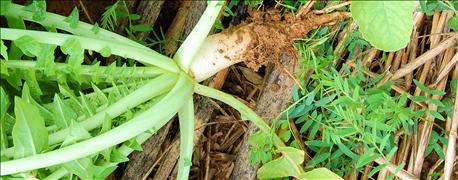June 1, 2016

Yes, it’s already seed shopping time for late summer or early fall cover crops. And, if you’re looking for a cover crop variety that suppresses weeds and helps hold soil nutrients over winter, forage radish may top the list.
That’s the bottom line of recent research from University of New Hampshire’s Ag Experiment Station. Weed control and soil health improvement are issues every farmer struggles to deal with, says Richard Smith, UNH agroecologist. Cover crops are tools that address them simultaneously. “However, not all cover crops are equally capable of suppressing weeds or contributing to soil enhancement, particularly under the climatic conditions typical of northern New England.”
In brief, the UNH research quantified cover crop biomass, weed suppression and carry-over effects on subsequent crop and weed growth in 12 winter cover crop treatments – monocrops and mixtures of annual ryegrass, winter rye, alfalfa, crimson clover, white clover, hairy vetch, soybeans and forage radish. The two-year study goal was to find the best options to fill the late summer and fall fallow period and springtime planting of the next season’s cash crop.
Soil health benefits
Forage radish treatments were among the most weed-suppressive in the fall, reducing weed biomass relative to the weedy fallow treatment by 89% to 97%. In the spring, annual ryegrass was among the highest biomass-producing cover crops; alfalfa was among the lowest.
“Forage radish was consistently among the highest biomass-producing treatments in the fall, provided excellent fall weed suppression and resulted in some of the highest production values in the test-crop,” explains Smith. “We were particularly surprised with how much impact it had on the subsequent test cash crop, despite the fact that [the radishes] died in the winter.”
While many New England farms already use cover crops, some vegetable farms have up to 50% of cropland in cover crops during growing season. The intent, he adds, is to improve soil health and sequester soil carbon.
Future research will assess a wider range of cover crop species and their performance under different growing conditions and planting at different times during the growing season. The UNH scientists also will continue to investigate potential benefits of cover crops in inter-cropping systems.
Check out the full “In-Season and Carry-Over Effects of Cover Crops on Productivity and Weed Suppression” report in the Agronomy Journal website article.
Compiled from a University of New Hampshire Extension release
You May Also Like




